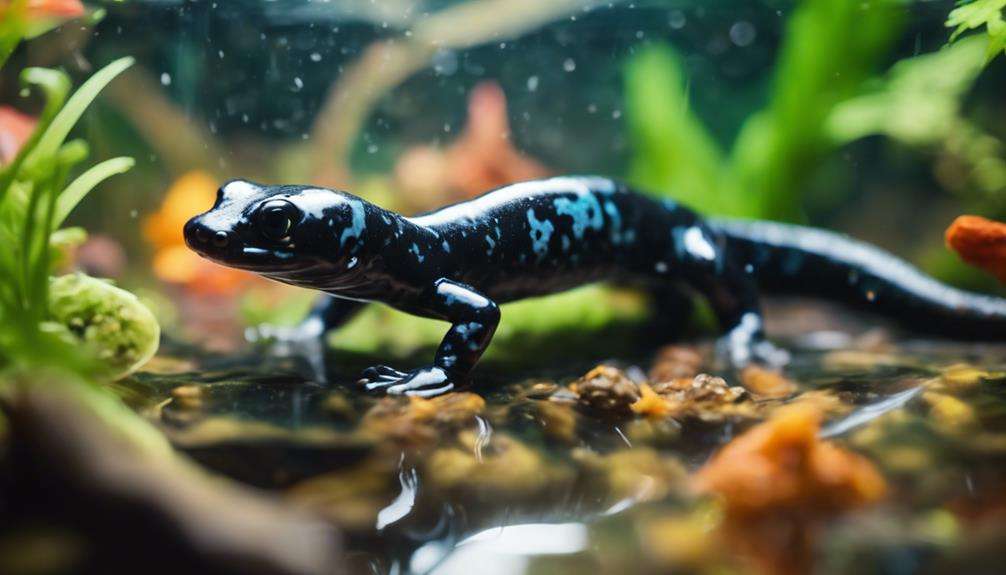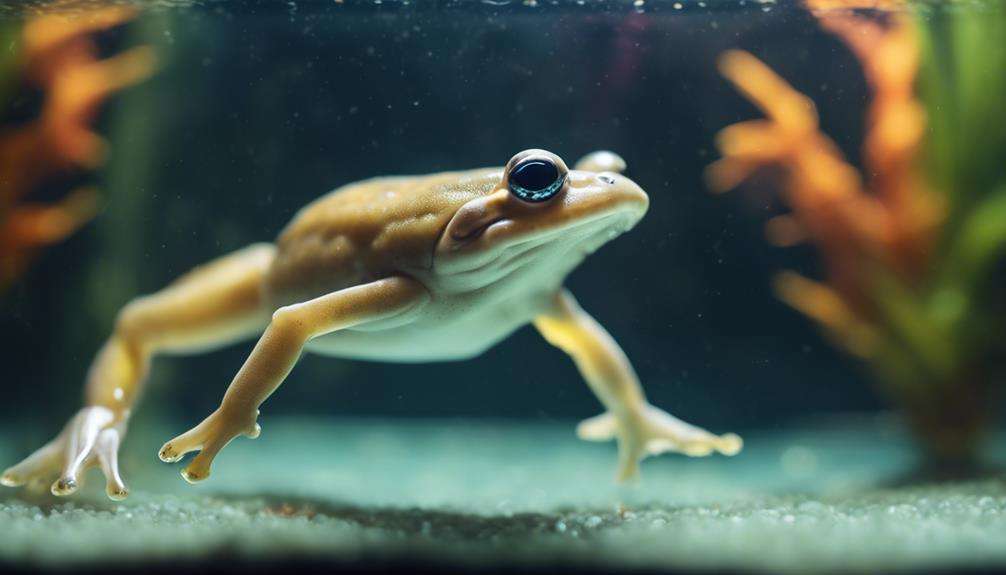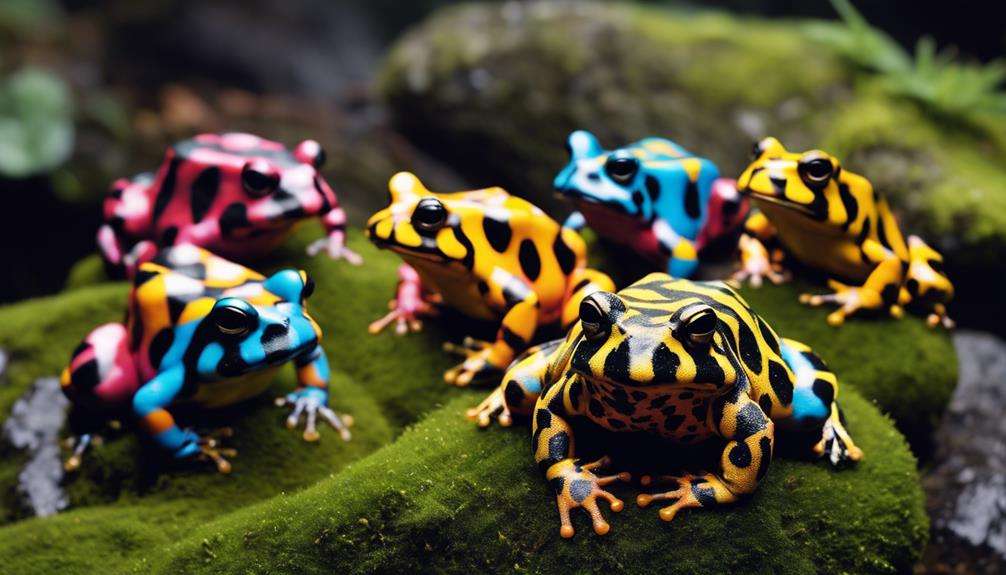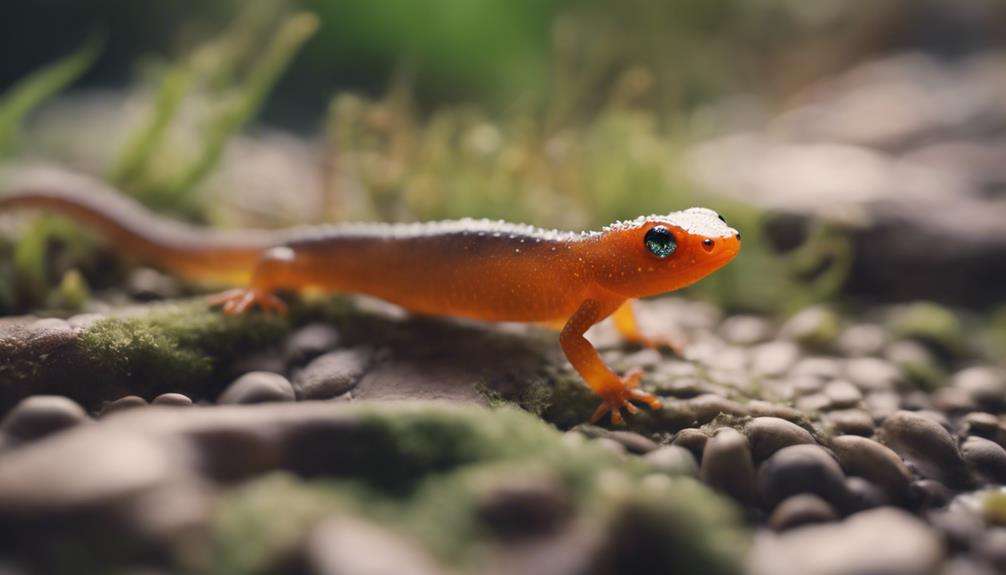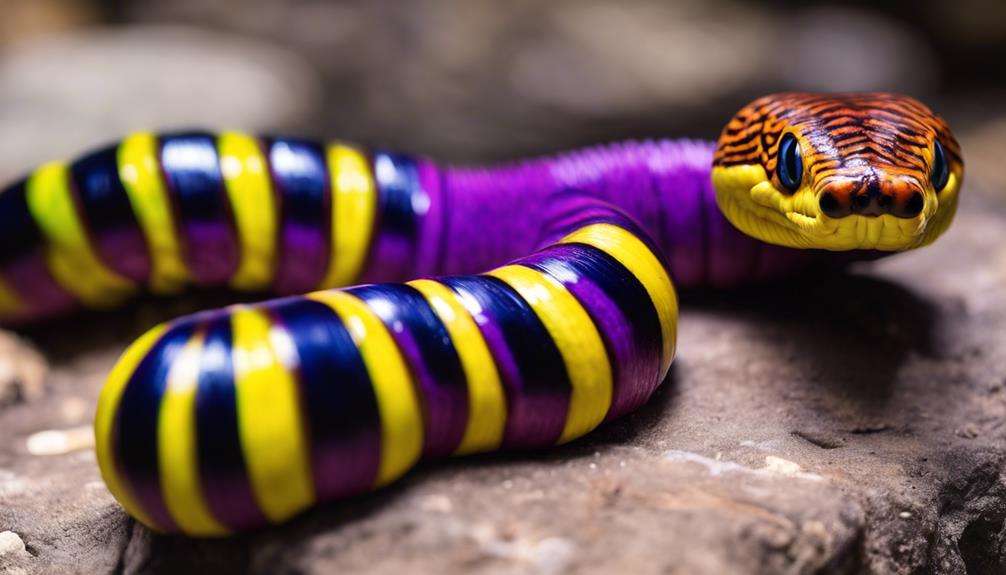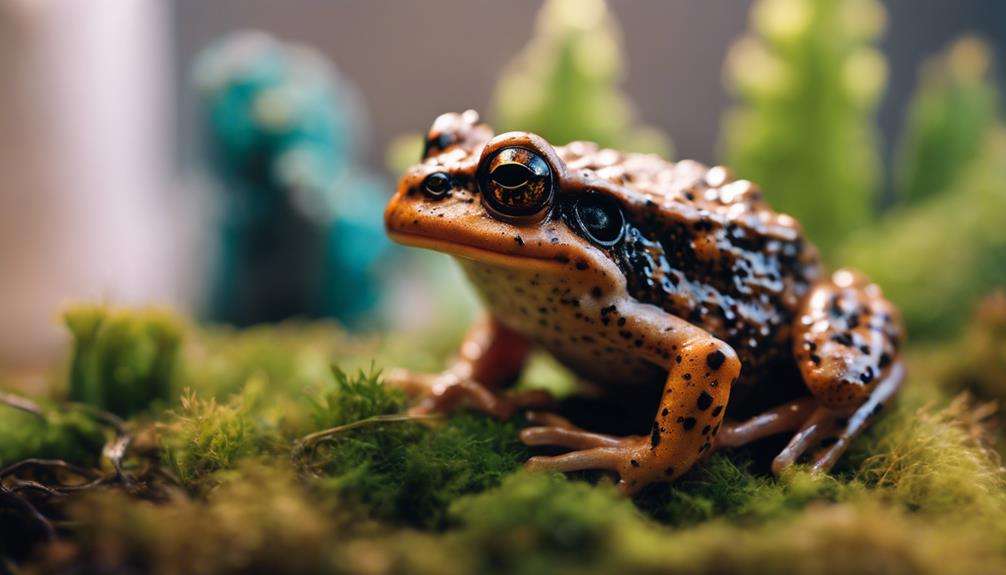Imagine a dense, misty forest echoing with the melodic chorus of unseen creatures. Amidst the vibrant foliage, tiny jewels of nature hop and leap, captivating enthusiasts with their mysterious allure.
These amphibians, with their intricate biology and captivating behaviors, offer enthusiasts a glimpse into a world both enchanting and scientifically intriguing.
The reasons behind frog enthusiasts' unwavering fascination run deep, intertwining curiosity, wonder, and a desire to unravel the secrets of these enigmatic creatures.
Key Takeaways
- Rare and unique features like vibrant colors and potent toxins captivate enthusiasts.
- Conservation efforts benefit from the beauty and distinctiveness of exotic amphibians.
- Rare frog habitats underscore the importance of conservation for diverse species.
- Uncommon frog appeal lies in their exclusive markings, behaviors, and specialized ecosystems.
Rare Frog Species for Enthusiasts
Exploring the world of rare frog species for enthusiasts reveals a fascinating array of vibrant colors, unique adaptations, and cultural significance.
For frog lovers, the backyard pond becomes a hub of excitement during breeding season as they anticipate the mesmerizing displays of these unique amphibians.
The Golden Poison Frog, with its bright yellow skin and potent toxins, is a coveted find for collectors seeking both beauty and danger in one species.
In contrast, the Purple Frog's secretive underground lifestyle and unusual appearance captivate enthusiasts looking for cryptic species that challenge traditional notions of frog biology.
The Panamanian Golden Frog, although critically endangered, holds immense cultural significance in Panama, drawing attention from conservationists and collectors alike.
Madagascar's Tomato Frog stands out with its striking red-orange coloration and ability to inflate its body, adding a touch of intrigue to any frog collection.
Lastly, the Vietnamese Mossy Frog's moss-like appearance and camouflage abilities provide a mysterious and charming allure for those fascinated by amphibian adaptations.
Exotic Amphibians in Frog Enthusiast Collections
What makes exotic amphibians like poison dart frogs and glass frogs so coveted by frog enthusiasts for their vibrant colors and unique characteristics?
Exotic amphibians hold a special place in enthusiast collections due to their impressive variety of frog species from diverse regions such as Central and South America, Australia, and Madagascar. Frog enthusiasts are drawn to the striking beauty and distinct features of these exotic amphibians, which showcase a kaleidoscope of colors and patterns that captivate the eye.
The allure of these frog species lies not only in their aesthetic appeal but also in their fascinating behaviors that highlight their adaptability to different environments. Enthusiasts often seek out rare and endangered frog species to support conservation efforts and raise awareness about the threats they face.
These exotic frogs serve as charismatic ambassadors for their kind, inspiring passion, research, and conservation initiatives among enthusiasts worldwide.
Unusual Frog Varieties for Enthusiasts
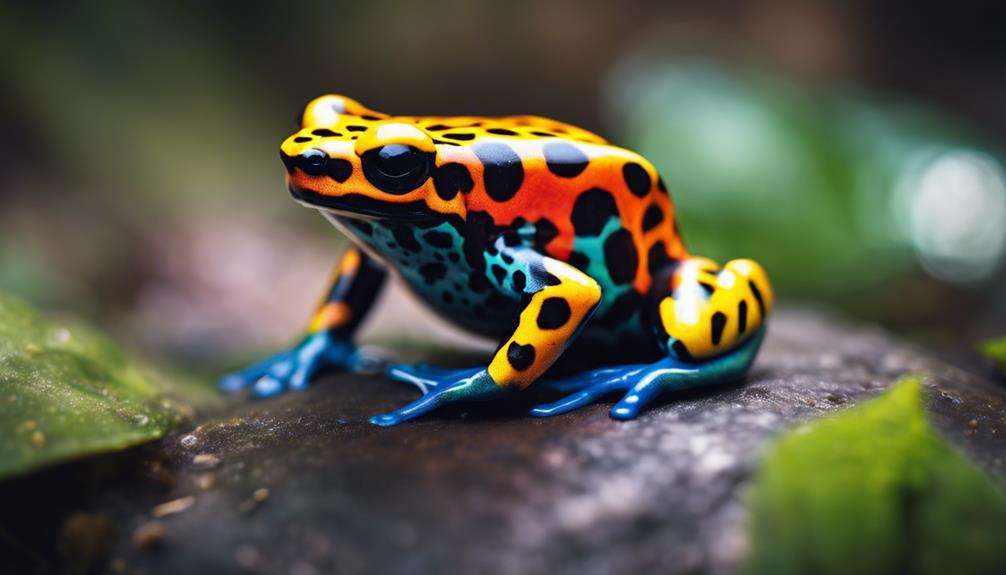
Have you ever marveled at the intricate camouflage abilities of the Vietnamese mossy frog, a unique and unusual variety that captivates enthusiasts with its moss-like appearance? This frog species blends seamlessly with its surroundings, making it challenging to spot in its natural habitat. Enthusiasts are drawn to such unusual frog varieties for their remarkable features and behaviors.
Unusual Frog Varieties for Enthusiasts:
- Vietnamese Mossy Frog:
- Known for its moss-like appearance.
- Exhibits exceptional camouflage abilities.
- Captivates enthusiasts with its unique features.
Enthusiasts also find the Amazon milk frog fascinating due to its striking blue and white coloration, which sets it apart from other frog species. Furthermore, the red-eyed tree frog, with its vibrant body colors and distinct red eyes, is a popular choice among collectors for its visual appeal and captivating presence in terrariums. These unique frog varieties offer enthusiasts the opportunity to observe and appreciate the diverse beauty found within the amphibian world.
Unique Frog Species That Intrigue Collectors
Among the intriguing species sought after by collectors, poison dart frogs stand out for their vibrant colors and toxic skin secretions. These frogs, originating from Central and South America, have been captivating enthusiasts for years. Their striking hues serve as a warning to predators about their toxicity, derived from the insects they consume.
The intricate patterns and colors not only deter predators but also attract females during mating rituals. Poison dart frogs exhibit complex behaviors, such as vocalizations and intricate courtship displays, making them even more fascinating to collectors.
Another species that intrigues collectors is the glass frog, known for its translucent skin that allows for a view of its internal organs. These unique frogs, found in various habitats around the world, have adapted to blend in with their surroundings. The transparent skin aids in camouflage while also attracting mates through visual cues.
Glass frogs have become highly sought after due to their remarkable biology and captivating appearance, making them prized additions to any collection.
Fascinating Finds: Rare Frogs for Enthusiasts
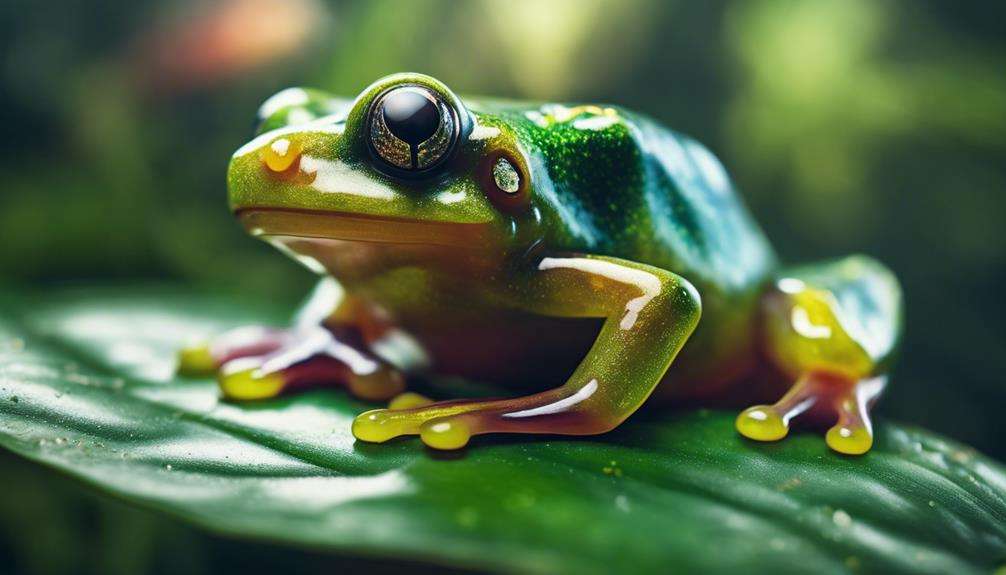
Rare frog species coveted by enthusiasts for their distinct characteristics and cultural significance include the Panamanian golden frog, the Titicaca water frog, the Malagasy rainbow frog, the Vietnamese mossy frog, and the Australian gastric-brooding frog.
The endangered species awareness surrounding these rare frogs drives enthusiasts to support conservation efforts aimed at protecting their habitats and ensuring their survival.
These frogs hold cultural significance in various regions, often intertwined with traditional beliefs that highlight their importance in local folklore and rituals.
Enthusiasts are drawn to these species due to their captivating appearances and unique behaviors, which set them apart from more common frog species and make them prized finds for collectors.
Observing these rare frogs not only offers enthusiasts a glimpse into the wonders of the natural world but also serves as a reminder of the importance of preserving biodiversity and understanding the delicate balance of ecosystems where these fascinating creatures reside.
Exotic Amphibians Captivating Frog Enthusiasts
Exotic amphibians, with their vibrant colors and unique toxins, have long captivated frog enthusiasts for their striking appearance and intriguing characteristics. These colorful adaptations serve various purposes, from warning predators of their toxicity to attracting potential mates. Poison dart frogs, for example, showcase a dazzling array of colors as a warning signal due to their poisonous nature.
The behavioral traits exhibited by these exotic amphibians are equally captivating. Glass frogs, with their translucent skin and bright green coloration, fascinate enthusiasts with their unique parenting behaviors, such as males guarding their eggs. The appeal of these species also extends to the importance of habitat preservation.
Frog enthusiasts are often advocates for conserving the habitats of these exotic amphibians, recognizing their role in maintaining the delicate balance of ecosystems. By appreciating these colorful creatures and understanding their behavioral intricacies, enthusiasts contribute to the conservation efforts necessary for the survival of these captivating species.
Special Frog Species Drawing Enthusiasts' Attention
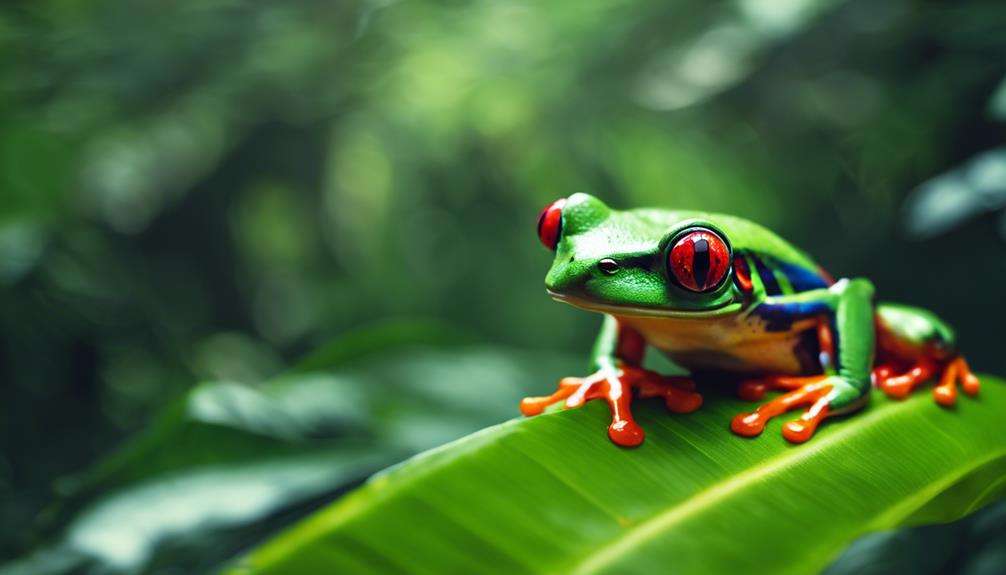
Special frog species, such as the poison dart frog and the glass frog, stand out due to their unique colors and rare habitats.
Enthusiasts are drawn to these frogs for their vibrant hues and intriguing living environments.
The striking appearances and specialized adaptations of these frog species make them particularly captivating to those who appreciate the wonders of the amphibian world.
Unique Frog Colors
Frogs of various species showcase a diverse array of vibrant and unique colors, captivating enthusiasts with their striking pigmentation. These vivid hues aren't only visually appealing but also serve as crucial adaptations for communication and camouflage in their natural habitats.
Some frog species exhibit colorful patterns that help them blend into their surroundings or warn predators of their toxicity. Vibrant hues play a significant role in attracting potential mates during the breeding season, ensuring the continuation of their species. Eye-catching shades serve as a form of defense mechanism, deterring predators and allowing these frogs to survive in diverse ecosystems.
The intricate color variations seen in these amphibians continue to fascinate and inspire frog enthusiasts worldwide.
Rare Frog Habitats
Rare frog habitats, like those found in remote tropical regions, are captivating enthusiasts with their unique ecosystems and diverse species. Cloud forest wonders in South America, known for their vibrant colors and rich biodiversity, house rare frog species that mesmerize enthusiasts.
The endemic Australian species, such as the corroboree frog, with their limited distribution and distinctive appearance, attract frog enthusiasts seeking rare finds. The Amazon rainforest's diversity is a hotspot for enthusiasts intrigued by poison dart frogs, known for their colorful appearances and potent toxins.
Exploring these habitats reveals a world of intricate interactions and adaptations, drawing enthusiasts deeper into the fascinating realm of rare frog species. From Madagascar to Southeast Asia, each habitat offers a glimpse into the remarkable diversity and beauty of these elusive amphibians.
Rare Amphibians That Enchant Frog Enthusiasts
With their unique features and captivating allure, certain amphibian species have a magnetic appeal for enthusiasts interested in exploring the extraordinary diversity of frogs.
Among these rare amphibians that enchant frog enthusiasts are:
- Toxic beauty: The Golden Poison Frog stands out with its vibrant yellow skin and potent toxins, captivating frog lovers with its striking appearance and deadly defenses.
- Mossy camouflage: The Vietnamese Mossy Frog intrigues enthusiasts with its moss-like camouflage and bumpy skin texture, making it a sought-after species for those fascinated by unique adaptations in nature.
- Underground lifestyle: The Purple Frog, known for its bulbous body shape and subterranean habits, remains elusive and mysterious, drawing in enthusiasts intrigued by its secretive underground lifestyle.
These rare amphibians not only showcase the incredible diversity of frogs but also offer enthusiasts a glimpse into the intriguing adaptations and behaviors that make each species so captivating.
Uncommon Frog Species Fascinating Collectors
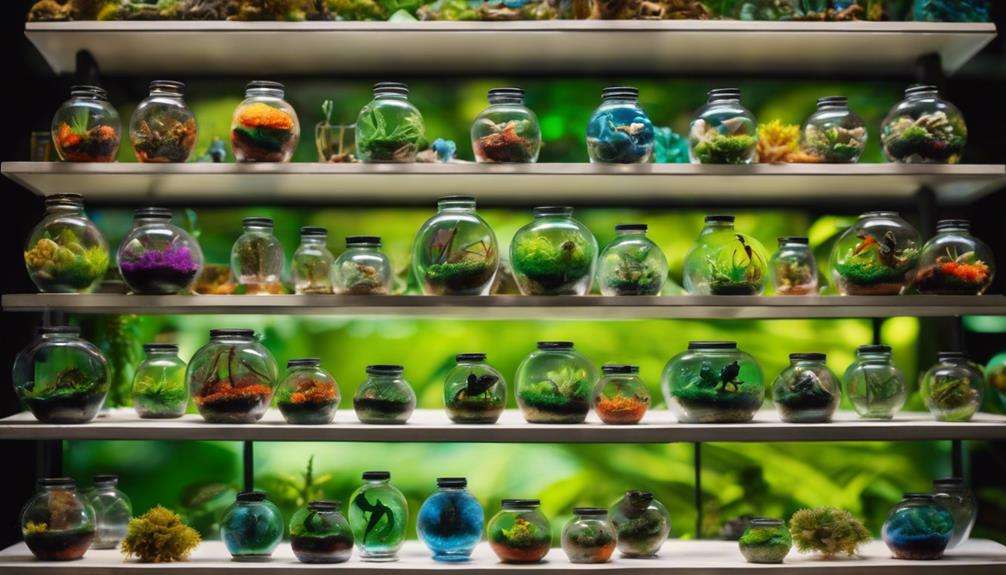
Rare frog species like the golden poison frog and the Vietnamese mossy frog captivate collectors with their unique colorations and patterns, drawing attention to the importance of biodiversity conservation efforts.
Enthusiasts are intrigued by the challenge of locating and caring for uncommon species such as the Panamanian golden frog and the Solomon Island leaf frog, highlighting the need for preservation programs.
The distinct traits and behaviors of these frogs, like the Amazon milk frog and the Vietnamese flying frog, emphasize the significance of maintaining genetic diversity in captive breeding initiatives.
Rare Frog Appeal
Fascinating collectors, uncommon frog species captivate enthusiasts with their unique characteristics and limited availability in the wild. These rare frogs exhibit behaviors, colorations, and habitats that set them apart from more common species:
- Uncommon frog behaviors: Some rare frog species display unique behaviors, such as intricate courtship rituals or specialized feeding habits, making them intriguing subjects for collectors.
- Rare frog colorations: The striking and distinctive color patterns found in uncommon frog species attract collectors seeking visually captivating additions to their collections.
- Unique frog habitats: Rare frogs often inhabit specialized ecosystems, like isolated rainforest pockets or high-altitude marshes, adding to their allure for enthusiasts interested in diverse habitats.
The exclusivity and challenge of acquiring these rare species further enhance their appeal to collectors.
Unique Markings Attract
Captivating collectors with their distinct patterns and colorations, uncommon frog species showcase a remarkable array of unique markings that contribute to their allure and desirability in enthusiast circles.
Marking diversity plays a crucial role in the aesthetic allure of these frogs, with uncommon patterns creating visual intrigue for collectors. The rare coloration found in species like the red-eyed tree frog adds to the fascination collectors have for these visually striking amphibians.
Unique markings, such as those seen on the Amazon milk frog and the harlequin mantella frog, make these species highly sought-after by enthusiasts looking for distinctive additions to their collections. The rarity and beauty of these markings set uncommon frog species apart, drawing collectors into the fascinating world of unique frog patterns.
Conservation Efforts Needed
Have conservation efforts adequately addressed the protection of uncommon frog species that captivate collectors with their unique appeal?
Conservation challenges persist in safeguarding these species, necessitating focused efforts on species protection. Threats to biodiversity and environmental impact pose significant risks to the survival of uncommon frog species. Endangered habitats further exacerbate the need for robust conservation strategies to mitigate the decline in population numbers.
It's imperative to allocate resources towards habitat restoration, pollution control, and sustainable development practices to ensure the long-term viability of these captivating frog species. By prioritizing conservation initiatives and fostering collaboration between collectors, enthusiasts, and conservation organizations, we can collectively work towards preserving the biodiversity and ecological balance that these uncommon frog species contribute to.
Frequently Asked Questions
Why Are Frogs so Fascinating?
Frogs are fascinating due to their unique behaviors like vocalizations for mating, diverse colors and habitats showcasing frog diversity, and conservation challenges highlighting the importance of protecting these species. Explore their world with wonder.
Why Do People Love Frogs?
You love frogs for their fascinating behavior. Their variety in species, like the vibrant poison dart frogs or the majestic tree frogs, captivates you. Furthermore, their role in conservation, as indicators of ecosystem health, inspires admiration.
Why Are Frogs Important to Our Ecosystem?
Frogs play a vital role in our ecosystem as biodiversity balancers, wetland protectors, and pest control agents. They contribute to nutrient cycling, serve as prey for predators, and help maintain habitat quality, reflecting environmental health changes.
Why Do You Think Frogs Are Used as One of the Common Laboratory Animal Models?
Frogs are common lab models due to their physiological similarities to humans, aiding genetic research and exploring behavior. Their environmental adaptations provide insights into regeneration studies. They offer ethical alternatives, aligning with the 3Rs principles.
Conclusion
You have explored the rare, exotic, and unusual frog species that captivate enthusiasts. From their colorful skin patterns to unique adaptations, these amphibians offer a glimpse into the fascinating world of biology.
As collectors and researchers alike are drawn to the cultural significance and educational value of frogs, their enduring appeal continues to intrigue and inspire.
Embrace the wonder of these special creatures and continue to discover the beauty and complexity of the frog kingdom.

